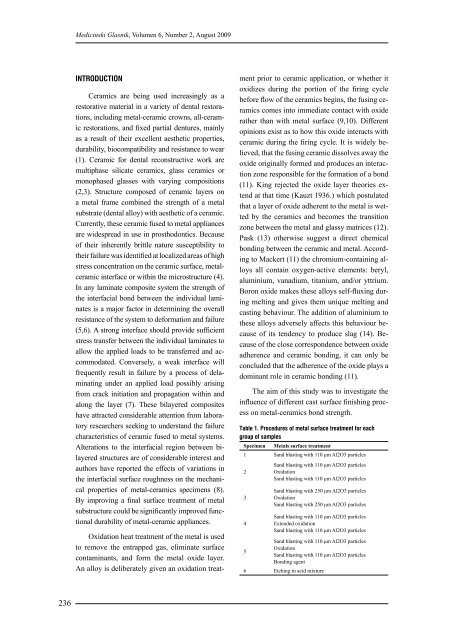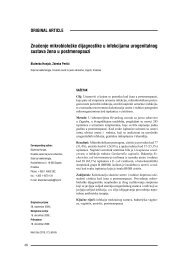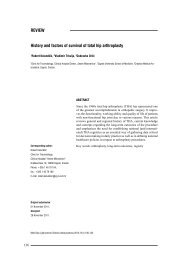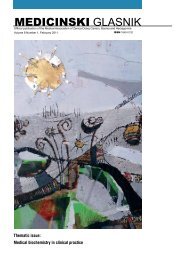Influence of cast surface finishing process on metal-ceramic bond ...
Influence of cast surface finishing process on metal-ceramic bond ...
Influence of cast surface finishing process on metal-ceramic bond ...
You also want an ePaper? Increase the reach of your titles
YUMPU automatically turns print PDFs into web optimized ePapers that Google loves.
236<br />
Medicinski Glasnik, Volumen 6, Number 2, August 2009<br />
INTRODUCTION<br />
Ceramics are being used increasingly as a<br />
restorative material in a variety <str<strong>on</strong>g>of</str<strong>on</strong>g> dental restorati<strong>on</strong>s,<br />
including <strong>metal</strong>-<strong>ceramic</strong> crowns, all-<strong>ceramic</strong><br />
restorati<strong>on</strong>s, and fixed partial dentures, mainly<br />
as a result <str<strong>on</strong>g>of</str<strong>on</strong>g> their excellent aesthetic properties,<br />
durability, biocompatibility and resistance to wear<br />
(1). Ceramic for dental rec<strong>on</strong>structive work are<br />
multiphase silicate <strong>ceramic</strong>s, glass <strong>ceramic</strong>s or<br />
m<strong>on</strong>ophased glasses with varying compositi<strong>on</strong>s<br />
(2,3). Structure composed <str<strong>on</strong>g>of</str<strong>on</strong>g> <strong>ceramic</strong> layers <strong>on</strong><br />
a <strong>metal</strong> frame combined the strength <str<strong>on</strong>g>of</str<strong>on</strong>g> a <strong>metal</strong><br />
substrate (dental alloy) with aesthetic <str<strong>on</strong>g>of</str<strong>on</strong>g> a <strong>ceramic</strong>.<br />
Currently, these <strong>ceramic</strong> fused to <strong>metal</strong> appliances<br />
are widespread in use in prosthod<strong>on</strong>tics. Because<br />
<str<strong>on</strong>g>of</str<strong>on</strong>g> their inherently brittle nature susceptibility to<br />
their failure was identified at localized areas <str<strong>on</strong>g>of</str<strong>on</strong>g> high<br />
stress c<strong>on</strong>centrati<strong>on</strong> <strong>on</strong> the <strong>ceramic</strong> <str<strong>on</strong>g>surface</str<strong>on</strong>g>, <strong>metal</strong><strong>ceramic</strong><br />
interface or within the microstructure (4).<br />
In any laminate composite system the strength <str<strong>on</strong>g>of</str<strong>on</strong>g><br />
the interfacial b<strong>on</strong>d between the individual laminates<br />
is a major factor in determining the overall<br />
resistance <str<strong>on</strong>g>of</str<strong>on</strong>g> the system to deformati<strong>on</strong> and failure<br />
(5,6). A str<strong>on</strong>g interface should provide sufficient<br />
stress transfer between the individual laminates to<br />
allow the applied loads to be transferred and accommodated.<br />
C<strong>on</strong>versely, a weak interface will<br />
frequently result in failure by a <str<strong>on</strong>g>process</str<strong>on</strong>g> <str<strong>on</strong>g>of</str<strong>on</strong>g> delaminating<br />
under an applied load possibly arising<br />
from crack initiati<strong>on</strong> and propagati<strong>on</strong> within and<br />
al<strong>on</strong>g the layer (7). These bilayered composites<br />
have attracted c<strong>on</strong>siderable attenti<strong>on</strong> from laboratory<br />
researchers seeking to understand the failure<br />
characteristics <str<strong>on</strong>g>of</str<strong>on</strong>g> <strong>ceramic</strong> fused to <strong>metal</strong> systems.<br />
Alterati<strong>on</strong>s to the interfacial regi<strong>on</strong> between bilayered<br />
structures are <str<strong>on</strong>g>of</str<strong>on</strong>g> c<strong>on</strong>siderable interest and<br />
authors have reported the effects <str<strong>on</strong>g>of</str<strong>on</strong>g> variati<strong>on</strong>s in<br />
the interfacial <str<strong>on</strong>g>surface</str<strong>on</strong>g> roughness <strong>on</strong> the mechanical<br />
properties <str<strong>on</strong>g>of</str<strong>on</strong>g> <strong>metal</strong>-<strong>ceramic</strong>s specimens (8).<br />
By improving a final <str<strong>on</strong>g>surface</str<strong>on</strong>g> treatment <str<strong>on</strong>g>of</str<strong>on</strong>g> <strong>metal</strong><br />
substructure could be significantly improved functi<strong>on</strong>al<br />
durability <str<strong>on</strong>g>of</str<strong>on</strong>g> <strong>metal</strong>-<strong>ceramic</strong> appliances.<br />
Oxidati<strong>on</strong> heat treatment <str<strong>on</strong>g>of</str<strong>on</strong>g> the <strong>metal</strong> is used<br />
to remove the entrapped gas, eliminate <str<strong>on</strong>g>surface</str<strong>on</strong>g><br />
c<strong>on</strong>taminants, and form the <strong>metal</strong> oxide layer.<br />
An alloy is deliberately given an oxidati<strong>on</strong> treat-<br />
ment prior to <strong>ceramic</strong> applicati<strong>on</strong>, or whether it<br />
oxidizes during the porti<strong>on</strong> <str<strong>on</strong>g>of</str<strong>on</strong>g> the firing cycle<br />
before flow <str<strong>on</strong>g>of</str<strong>on</strong>g> the <strong>ceramic</strong>s begins, the fusing <strong>ceramic</strong>s<br />
comes into immediate c<strong>on</strong>tact with oxide<br />
rather than with <strong>metal</strong> <str<strong>on</strong>g>surface</str<strong>on</strong>g> (9,10). Different<br />
opini<strong>on</strong>s exist as to how this oxide interacts with<br />
<strong>ceramic</strong> during the firing cycle. It is widely believed,<br />
that the fusing <strong>ceramic</strong> dissolves away the<br />
oxide originally formed and produces an interacti<strong>on</strong><br />
z<strong>on</strong>e resp<strong>on</strong>sible for the formati<strong>on</strong> <str<strong>on</strong>g>of</str<strong>on</strong>g> a b<strong>on</strong>d<br />
(11). King rejected the oxide layer theories extend<br />
at that time (Kauzt 1936.) which postulated<br />
that a layer <str<strong>on</strong>g>of</str<strong>on</strong>g> oxide adherent to the <strong>metal</strong> is wetted<br />
by the <strong>ceramic</strong>s and becomes the transiti<strong>on</strong><br />
z<strong>on</strong>e between the <strong>metal</strong> and glassy matrices (12).<br />
Pask (13) otherwise suggest a direct chemical<br />
b<strong>on</strong>ding between the <strong>ceramic</strong> and <strong>metal</strong>. According<br />
to Mackert (11) the chromium-c<strong>on</strong>taining alloys<br />
all c<strong>on</strong>tain oxygen-active elements: beryl,<br />
aluminium, vanadium, titanium, and/or yttrium.<br />
Bor<strong>on</strong> oxide makes these alloys self-fluxing during<br />
melting and gives them unique melting and<br />
<str<strong>on</strong>g>cast</str<strong>on</strong>g>ing behaviour. The additi<strong>on</strong> <str<strong>on</strong>g>of</str<strong>on</strong>g> aluminium to<br />
these alloys adversely affects this behaviour because<br />
<str<strong>on</strong>g>of</str<strong>on</strong>g> its tendency to produce slag (14). Because<br />
<str<strong>on</strong>g>of</str<strong>on</strong>g> the close corresp<strong>on</strong>dence between oxide<br />
adherence and <strong>ceramic</strong> b<strong>on</strong>ding, it can <strong>on</strong>ly be<br />
c<strong>on</strong>cluded that the adherence <str<strong>on</strong>g>of</str<strong>on</strong>g> the oxide plays a<br />
dominant role in <strong>ceramic</strong> b<strong>on</strong>ding (11).<br />
The aim <str<strong>on</strong>g>of</str<strong>on</strong>g> this study was to investigate the<br />
influence <str<strong>on</strong>g>of</str<strong>on</strong>g> different <str<strong>on</strong>g>cast</str<strong>on</strong>g> <str<strong>on</strong>g>surface</str<strong>on</strong>g> <str<strong>on</strong>g>finishing</str<strong>on</strong>g> <str<strong>on</strong>g>process</str<strong>on</strong>g><br />
<strong>on</strong> <strong>metal</strong>-<strong>ceramic</strong>s b<strong>on</strong>d strength.<br />
Table 1. Procedures <str<strong>on</strong>g>of</str<strong>on</strong>g> <strong>metal</strong> <str<strong>on</strong>g>surface</str<strong>on</strong>g> treatment for each<br />
group <str<strong>on</strong>g>of</str<strong>on</strong>g> samples<br />
Specimen Metals <str<strong>on</strong>g>surface</str<strong>on</strong>g> treatment<br />
1 Sand blasting with 110 μm Al2O3 particles<br />
2<br />
3<br />
4<br />
Sand blasting with 110 μm Al2O3 particles<br />
Oxidati<strong>on</strong><br />
Sand blasting with 110 μm Al2O3 particles<br />
Sand blasting with 250 μm Al2O3 particles<br />
Oxidati<strong>on</strong><br />
Sand blasting with 250 μm Al2O3 particles<br />
Sand blasting with 110 μm Al2O3 particles<br />
Extended oxidati<strong>on</strong><br />
Sand blasting with 110 μm Al2O3 particles<br />
Sand blasting with 110 μm Al2O3 particles<br />
Oxidati<strong>on</strong><br />
5<br />
Sand blasting with 110 μm Al2O3 particles<br />
B<strong>on</strong>ding agent<br />
6 Etching in acid mixture












